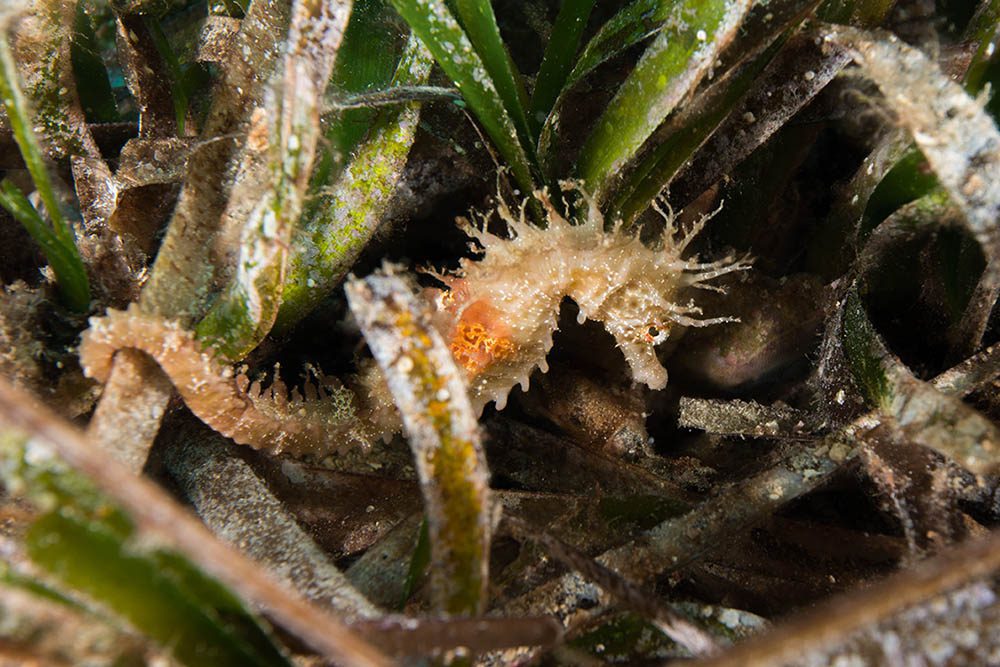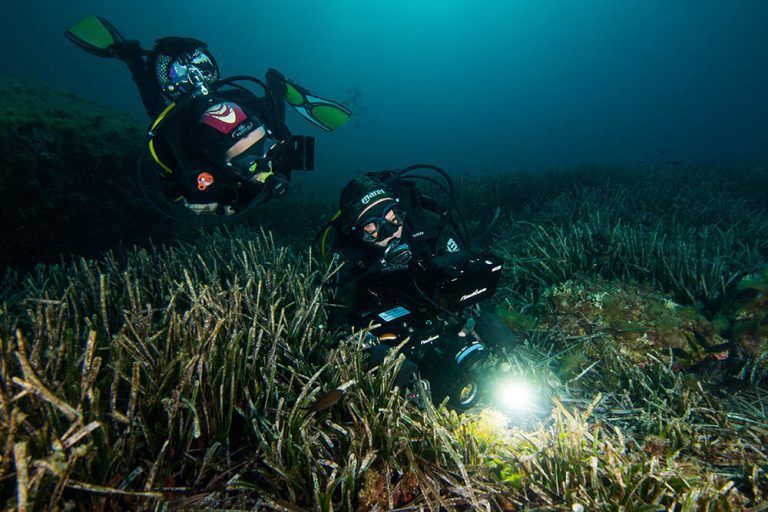A seagrass festival in the Balearics? Would there be enough to write about? RICHARD ASPINALL didn’t know it, but he was about to live his dream
- 1) An Unexpected Seahorse Encounter
- 2) The Journey to Formentera
- 3) Formentera: A Sustainable Tourism Destination
- 4) The Importance of Seagrass: A Talk with Pierre-Yves Cousteau
- 5) Diving with Vellmari Dive Centre
- 6) Exploring the Underwater World of Formentera
- 7) Discovering the Island Above Water
- 8) A Second Dive at Es Banc
- 9) Capturing Underwater Life
- 10) The End of a Perfect Dive Experience
- 11) A New Appreciation for Seagrass
- 12) SEAGRASS BIOLOGY
- 13) FACTFILE
An Unexpected Seahorse Encounter
THERE ARE FEW PEOPLE as pleased with themselves as divers who have just photographed their first seahorse! I’ve been diving for 13 years, and these wonderfully charming and downright odd-looking fish have always managed to elude me.
Many a dive-guide has told me that had I been around last week I would have been in luck, or something similar.
I did wonder if I was the victim of a conspiracy, attempts to see for how long I could be convinced to stare at weed-covered rocks. No longer, however – I am finally part of the seahorse-spotters’ club – not a claim I thought I’d be making after a trip ostensibly all about seagrass.
The Journey to Formentera
What can I say that’s interesting about seagrass? I had pondered that question as the ferry pulled out of the Balearic island of Ibiza, heading for the smaller and much quieter island of Formentera.
It was a short journey, past a series of low rocky islands and beaches that suggest that Formentera doesn’t really want to be separated from its bigger brother. The two seem to reach out towards one another, reluctant to let go.
Formentera’s water looked clear, and I could see sandy patches and darker areas of seagrass full, I hoped, of interesting critters.

I found myself thinking about the way we interact with life in the shallows, especially the plants. I suspect that many of us tend to ignore the green leafy stuff in the pursuit of depth, or a wreck, for example. Seagrass, or even stands of kelp and wrack in UK waters, might be something to have a quick gander at on a deco stop, but unlikely to be sought out as a “destination” in itself.
What would I be able to say about seagrass, and would I be able to photograph anything of interest? My itinerary showed only two dives, in between the talks and visits to beaches.
This was going to be a challenging assignment, I suspected, but with scuba-diving you never quite know what you’re going to get or who you’ll meet.
Formentera: A Sustainable Tourism Destination
Formentera is a small island reliant on the tourist trade and keen, it would appear, to develop without damaging its flora and fauna, on land or beneath the surface. Part of that approach lies in recognising and valuing what the island has a great deal of, and that’s seagrass.
The Importance of Seagrass: A Talk with Pierre-Yves Cousteau
I’d been invited to cover the island’s Save Posidonia Festival, a series of events designed to encourage locals and tourists alike to value Formentera’s rather special underwater meadows. I was later to learn that these are some of the oldest and largest living organisms on the planet.
AFTER A QUICK SNORKEL from the beach at Es Pujols on Formentera’s north-eastern flank to look at some seagrass meadows, I headed inland to the town of Sant Francesc Xavier, to ask Pierre-Yves Cousteau what made Posidonia so important.
Pierre-Yves, the youngest son of Jacques, had been invited to talk about how much carbon seagrass meadows absorb and lock up in their roots, and in the reefs they create.
Chatting after his address, he told me how seagrass meadows, especially Posidonia oceanica (which is found only in the Mediterranean), is far more efficient at storing carbon than any forest, and that some reefs can be many thousands of years old, with certain meadows shown to be massive colonies of the same individual.
All very fascinating, but I was itching to get under water. The next day I would get my chance.
Diving with Vellmari Dive Centre
I was diving with the Vellmari centre, located on the harbourside at La Savina, the island’s capital and ferry port. Vellmari is owned by Manu San Felix, a tremendously skilled underwater videographer and photographer himself and a friend of Pierre-Yves, who had decided to join us. I was in fine company.
We headed out of the port and into the marine-protected area that covers a fair chunk of the island’s surrounding waters.
Leaving La Savina, we turned left, rounding the rocky outcrop of Punta de sa Pedrera before mooring to a buoy at a site called Es Banc.
The sun was high in the sky, and the vis looked great. “We’ll follow the ridge to a shoal of barracuda,” said Manu. “Past an arch and then maybe we’ll see a seahorse.” That all sounded far too much to expect from one dive, I thought.
Exploring the Underwater World of Formentera
THE WATER TEMPERATURE was around 23°, and as I dropped to a seagrass meadow below me and turned my spotting torch on, what appeared from above as dark and dingy stands of seagrass came alive with life.
Amid the plants’ roots were delicate growths of algae, coral-like with their calcified structures. Orange and yellow sponges, lace corals, cup corals and tubeworms were everywhere among the Posidonia’s fibrous roots. I was quickly gaining a new appreciation for the stuff.
The plants’ long strappy leaves were covered in minute life and, at the roots, new bright green leaves were growing.
A slightly rockier area held an octopus that eyed me warily. It had collected shell remains and rocks around its hole for protection, and was holding them ready to pull over its head if I got too close.
Everyone had now descended. We all signalled OK and finned across the meadows alongside a limestone ridge that soon gave way to a fine arch, with a span of 5 or 6m.
Several large grouper, and a shoal of brown meagre and zebra bream parted to let us explore. Small, bright red cardinalfish hung close to the arch’s ceiling, while growths of Posidonia atop the structure looked like wild tufts of hair.
The cardinalfish, not caring which way was up, were upside-down, holding station just beneath the arch’s roof.
Before long we encountered the barracuda. Manu had said that they were approachable, and he was right.
As we took up position for a shot or two, they slowly circled above us. It was hard to estimate their numbers, but there were at least a hundred, sunlight glinting on their silver flanks.
We turned and headed back, past the mooring-line, sunlight streaming down.
I was bothering a few more octopuses until Jose, one of Vellmari’s team, started banging on his tank like a man possessed.
He was pointing and calling me over in between making a racket, pointing into the Posidonia. And there, on the edge of a patch of seagrass, tail wrapped around a leaf-blade, was the first seahorse I had ever seen in the wild.
Slightly cursing my wide-angle lens, I finned ever so slowly towards the shy animal to marvel at its camouflage. I took a few shots and pulled back, allowing Manu in with his video camera. We were all rather pleased with ourselves!
Back on the boat, Pierre-Yves and I confided to each other that this seahorse was a first for both of us!
Discovering the Island Above Water
Next morning, I took a little time to explore the island, visiting salt-pans, bird reserves and dunes before joining Vellmari for one more dive. I’d asked for another chance to shoot close-ups, and fitted a macro lens.

A Second Dive at Es Banc
Was I being greedy? I’d enjoyed an almost perfect dive the day before. “There are many nudibranchs at Es Banc,” Jose suggested, and I didn’t need much arm-twisting. A few nice nudis would be fine, and you never know, the seahorse might still be there, I thought to myself.
Capturing Underwater Life
The vis had improved a little, with a mild current from the south, to at least 30m. We found a few bright purple Flabellina nudibranchs quite quickly, and I set to work trying to shoot these delicate animals, with their fine cerrata flailing in the current.
I kept looking over to Jose, who was scouring the seagrass bed, hoping to find another seahorse. I found another nudi, this time a migrating aeolid, and then decided to join him.
The End of a Perfect Dive Experience
In a perfect world, and to make for a better story, we’d have spotted one with minutes to spare… or even two, but we all know that diving doesn’t work like that.
Still, I had my seahorse pics and an almost perfect dive. I mentally wished the curious little fish well in all that lovely Posidonia, stretching into the distance.
My last memory of the dive was of handing my camera up onto the boat and looking down at the seagrass, and seeing it swaying gently in the current.
A New Appreciation for Seagrass
Of all the thousands of years it’s been there, providing refuge for uncountable numbers of animals, long may it prosper. I remained smug for quite some time.
SEAGRASS BIOLOGY
- Seagrass is a true flowering plant, one of the few that has managed to colonise the oceans. Some 60 species are found worldwide.
- Seagrass is important in protecting coastlines through storms and wave action and provides shelter and food for significant numbers of animals, from seahorses to turtles. In winter it protects beaches from erosion, in turn protecting sand dunes.
- The role of seagrass in locking up carbon from the ocean has been overlooked in the past, but seagrass meadows account for more than 10%of the oceans’ total carbon storage. By protecting them we can help to limit ocean-acidification and global-warming.
- Formentera’s seagrass meadows could be more than 200,000 years old according to one study.
- Seagrass meadows are threatened by discharge of untreated sewage, damage from anchoring and removal to make beaches more attractive to holiday-makers.
- Seagrass leaves, when washed ashore, were once used as animal bedding and fertiliser.
FACTFILE
GETTING THERE: Several airlines fly to Ibiza from UK airports. Ferries from there to Formentera are fast and frequent. Tickets can be bought on the ferry or online. Those operated by Trasmapi are ideal for foot passengers, trasmapi.com. Car and scooter hire is available in La Savina, near the ferry terminal.
DIVING: Vellmari Diving Center offers diving and training for all skill levels to sites around the island. Nitrox and rental gear are available
ACCOMMODATION: Richard stayed at the Insotel Hotel Formentera Playa.
WHEN TO GO: You can dive year round, but fewer tourist businesses are open in winter and fewer flights are on offer.
CURRENCY: Euro
PRICES: Return flights to Ibiza from around £90pp, ferry about 40 euros pp return. Seven days at the Insotel Hotel 685 euros pp (two sharing, prices for June). A 10-dive pack with Vellmari costs 350 euros.
VISITOR Information: The trip was sponsored by the Formentera Tourist Board in collaboration with the Balearic Islands Tourist Board.

